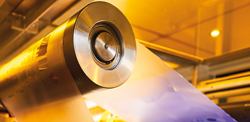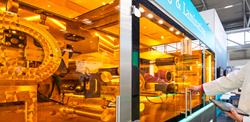04/2020 – 03/2024 – FlexFunction2Sustain
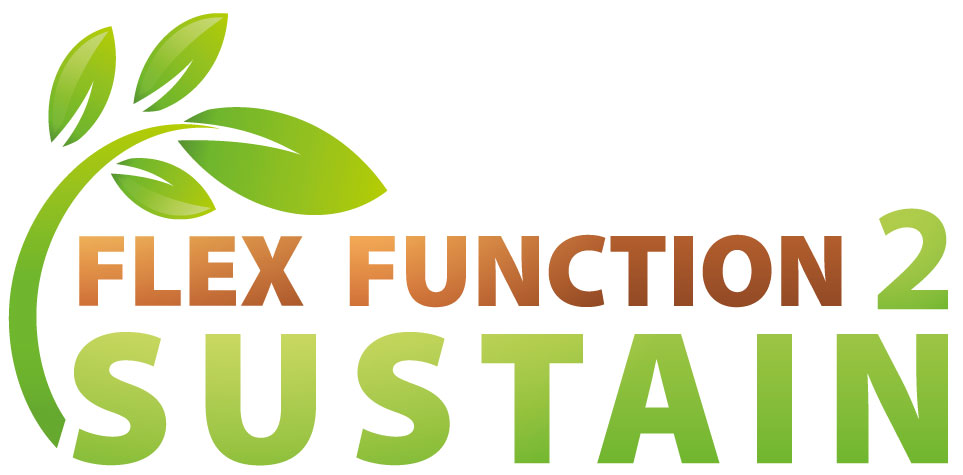

Open Innovation Ecosystem for Sustainable Nano-functionalized Flexible Plastic and Paper Surfaces and Membranes
Plastic and paper-based products are omnipresent in well-established multi-billion Euro markets such as food and pharma packaging. Furthermore, due to the replacement of traditional rigid glass and metal surfaces or substrates by nano-functionalized plastic or paper surfaces new opportunities and applications are emerging. However, the plastic waste pollution is still an issue of capital importance that one has to overcome.
The FlexFunction2Sustain project will support plastic and paper processing industry in overcoming these challenges by offering an Open Innovation Test Bed (OITB) for nano-functionalization technologies that enable sustainable and smart plastics- and paper-based products.
The OITB will create a holistic integrated service portfolio including technical and non-technical aspects of the innovation chain. The ecosystem will support its customers in material and product design, in process and product development, in product verification and certification, with pilot and small series production services and with accessing new markets and business opportunities.
To extent the service portfolio of the OITB the equipment at different facility clusters will be upgraded and validated in industrial use cases from P&G, SONAE, Huck Folien, Capri Sun, Fiat and I3 membranes. These upgrades will allow the OITB to offer services for advancing new surface functionalities ranging from laboratory validation (TRL4) up to validation in an operational/industrial environment (TRL7).
Within this project Coatema will upgrade four different pilot lines:
- Nanoimprint line at Joanneum Research
- Organic and printed electronics production line at the Aristoteles University of Thessaloniki
- Roll-to-roll ALD system at Fraunhofer IVV
- Modular Click&CoatTM pilot line at the Coatema R&D centre
Together with our partners we will scale up pilot-production processes, enhance the automation, improve the yield and impended new technologies.
https://flexfunction2sustain.eu
03/2020 – 02/2023 – RealNano

In-line and Real-time Nano-characterization technologies for the high yield manufacturing of Flexible Organic Electronics
Organic & Printed Electronics (OE) nanolayers is one of the most rapidly emerging sector of Nano Science and Technology. While the OE market is rapidly growing worldwide, from 31.7 B$ in 2018 to 77.3 B$ in 2029, the industrial manufacturing cannot meet the more extensive commercialization demands on speed, reliability, materials quality, final product efficiency, and stability.
The RealNano project will play a significant role in the digital transformation of the EU industries, with an ambitious aim to demonstrate a yield improvement of up to 90%, in combination with above 30% reduction on wastes and resources for nanomaterials. In order to accomplish this, novel and fast real-time nano-characterization material tools & methodologies based on spectroscopic ellipsometry, raman spectroscopy, imaging photoluminescence, and laser beam induced current mapping will be integrated to in-line R2R printing - and organic vapor phase deposition pilot-to-production lines.
In this project, Coatema is focussing on the mechanical integration of the developed characterization tools and the mechanical improvement of the R2R pilot-to-production line.
http://www.realnano-project.eu
02/2019 – 05/2023 – PEPcat
![]()


Energy-efficient advanced oxidation for removal of organic substances in wastewater through Plasmonically Enhanced Photocatalysis
The Institute for Urban Water Management and the Institute for Environmental Research at RWTH Aachen University are developing a novel process for oxidative water purification in cooperation with AMO GmbH (Aachen), Coatema GmbH (Dormagen), UMEX GmbH Dresden (Dresden) and HOLINGER Ingenieure GmbH (Merklingen), as well as Beijing Capital Company Ltd. (Beijing, China).
The aim of this project is to increase the elimination of so-called organic trace substances, such as pharmaceutical residues, which are only insufficiently retained in the normal purification process. The developed coating technology which the partners have named „PEPcat“, allows post treatment of waste water effluents via sunlight using almost no energy or chemicals in case of success. During the demonstration project for investigating this plasmonically enhanced photocatalysis with sunlight, experiments will be performed using waste water at the sewage treatment plants in Aachen-Soers and Beijing Dongba.
The special feature of this project is the direct implementation of the small-scale research of PEPcat into the industrial production scale. In this context, Coatema will take over the upscaling of the process as well as the planning of a pilot line to produce nanostructures. By implementing a Roll-to-Plate (R2P) concept, production bottlenecks can be avoided and the future scaling of nanostructuring for even larger substrate areas or for the production of nanostructured substrates can be realised.
09/2019 – 08/2022 – EffiLayers
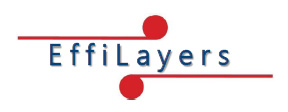

„Process optimization regarding the roll-to-roll production of novel highly efficient organic photovoltaic cells-EffiLayers“
The EffiLayers project as the successor of Photonflex (2016 – 2019) and Flexlas (2012 – 2015) is focussing on the development, process optimization, and production of flexible, highly efficient, and ultra-thin organic solar cells using a roll-to-roll coating system.
Organic photovoltaic cells currently still exhibit lower efficiency and durability compared to traditional silicon-based solar cells. The qualification of novel and efficient materials, as well as the optimization of the coating application by means of roll-to-roll coating equipment, should contribute to a significant increase in efficiency.
Through wet chemical coating processes, the functional layers are applied in the nanometer scale by using a heatable slot-die and processed with different laser sources (short pulse and ultra-short pulse range). After photonic laser drying and thin-film ablation, the OPV cell is protectively sealed by laser encapsulation with a barrier film. The individual processes are monitored by various sensors, and a process control system is implemented.
In this project, Coatema is focusing in particular on the modification of the entire slot-die application process. The novel swiveling die-module enables a stable process through variable adjustment of the die in the range of 8 to 12 o’clock. A proposed horizontal mechanism for adjusting the die ensures precise adjustment or positioning of the substrate to be coated during multiple coating processes. For a uniform application of the substrate, an electrically heated die is used.
In collaboration with the partners, the new process optimizations of the roll-to-roll production are demonstrated and evaluated for the novel OPV cell.
01/2018 – 12/2021 – Greensense


Sustainable, wireless, autonomous nanocellulose-based quantitative Drugs-of-Abuse (DoA) biosensing platform
Printed electronics is one of the fastest growing technologies in the world. Paper and plastic are two types of flexible materials that constitute key substrates in the development of future flexible electronic devices. On the contrary of those based on more conventional plastic substrates, paper-based electronics, made from cellulose, have the advantages of low cost, recyclability and can be expected to have a significant impact in the reduction of environmental impact of "electronic trash" and in providing new opportunities to the pulp/paper manufacturing industry. Unfortunately, the surface properties of conventional paper are not suitable for printed electronics and, typically plastic coatings based on fossil-oil polymers are applied. From a sustainable point of view, this has augmented the interest in alternative renewable biopolymer films and coatings with similar properties. Among the different alternatives, nanocellulose (NC) based films with strength, high aspect ratio, transparency and low porosity and smooth surface roughness are a promising potential alternative.
In the project GREENSENSE we merge healthcare diagnostics and printed electronics in the form of a fully-integrated biosensing platform using nanocellulose. The biosensing platform with the newly developed printed DoA biosensors will integrate different NC-based printed electronic components (supercapacitor and/or a primary battery as printed energy storage (E. storage), display and NFC antenna) and a single microchip to have energy autonomy, wireless communication and to be easy for the user to read the results. High output printing techniques, such as sheet-to-sheet (S2S) screen printing and/or inkjet printing will be used for the printing of the different functional inks onto NC-based substrates. The final NC-based biosensing platform will be easy to operate, flexible, mass producible, cost-effective, environmentally friendly, disposable, and recyclable and will have low power and energy consumption.
https://www.greensense-project.eu/
10/2018 – 09/2021 – OLEDSOLAR


Innovative manufacturing of opto-electronic devices
Emerging opto-electronic devices open the way for exciting new applications every day. Meeting industry’s requirements for mass production of such smart next-generation devices requires addressing a range of emerging challenges to enable best-value production at high manufacturing volumes and optimal efficiency.
OLEDSOLAR aims to tackle these challenges by developing innovative manufacturing processes for critical steps in the production of opto-electronic devices, including Organic LED (OLED), organic photovoltaics (OPV) and copper indium gallium selenide (CIGS) based solar cells. Related project activities include scaling up reconfigurable high-yield processes, testing them in pilot lines and validating them in production lines.
A complete system of inspection, quality control, functional testing and measurements using advanced systems and sensors will be optimised in the project for efficient manufacturing of opto-electronics parts. A special focus here is on automation and advance data processing for the overall control and monitoring of roll-to-roll (R2R) and sheet-to-sheet (S2S) manufacturing processes. At the same time, recycling and re-use strategies will be developed to ensure resource efficiency and reduction of high-value product waste.
Coatema’s role is to further improve registration in R2R technologies at the Coatema R&D centre and at the Printocent demo line at VTT. Here Coatema will integrate the registration camera by VTT into the demo line and improve machinery in order to improve the overlay between consecutive printing jobs down to an accuracy of 50 micrometers or better for screen printing technology.
10/2017 – 06/2021 – SOLID


Innovative solid state batteries based on sol-gel materials with a Li-metal anode and implemented 3D structure.
One key factor regarding the electro mobility future are inherently safe and power efficient battery technologies. Solid state approaches have the potential to fulfil these demands. Up to now the used processes and methods are not economical efficient scalable and the energy density is too low.
The objective within the project SOLID is the investigation of a solid state batteries based upon cost efficient production methods that are completely transferable to industrial scale respectively are already established in other sectors. The solid state approach enables one to use new cell concepts leading to a lower part of electro-chemical inactive materials and a lower cabling complexity. Starting from a material research for cathode- and electrolyte layers by the Fraunhofer ISC as well as an anode development by Applied Material solid state batteries in single layer format can be produced. Besides this, the Fraunhofer ISE investigates structuring of the electrical conductor and the cathode layer to reduce the intrinsic high resistances. Additionally LUNOVU develops novel laser-based methods for the crystallization behaviour of the cathode- and electrolyte layers. Coatema is going to transfer all methods to continuous processes or respectively Coatema is going to investigate the opportunity for an integration into a continuous process. The whole project is led by project coordinator Varta that is going to develop a new cell concept cooperating with all partners. Finally, the operational reliability of this solid state approaches is proven by a demonstrator.
The battery market is strongly dominated by Asian manufacturers. To participate in this market or even acquire a leadership it is important to execute basic research in the field of this future technologies. This project will create jobs along the whole supply chain, by the project lead of German small and medium size companies that use established German technologies.
01/2018 – 12/2020 – Supersmart


Scale-Up of Printed Electronics Recyclable SMART materials
In day to day products, including labels and packaging, there is a rising consumer demand for smart products, that is to say, objects that are able to be part of a digital ecosystem. Embedding sensors and communications technologies while minimizing the environmental impact of these smart products is a key challenge for the future. The major way of achieving this is to work on the base materials of the electronics components to be embedded in, by providing organic materials instead of rare and toxic inorganic ones when applicable. That is the objective of the SUPERSMART project which will enable the direct printing on paper of sensors, displays and electronics instead of bulk conventional electronics devices. It will make the recyclability of such smart products easy. Lead by Arkema, a world-wide chemical actor, together with Arjowiggins, providing technical papers for printed electronics, leading technical organizations (CEA, FraunhoferInstitute, Joanneum Research), first-class universities (University de Bordeaux and Lisbon) and innovative SMEs (Coatema, Luquet & Duranton), the SUPERSMART project aims at scaling up printable smart materials for the smart and recyclable products of the future.https://www.supersmart-project.eu/
06/2017 – 5/2020 – Flex-G


Development of R2R technologies for producing flexible facade elements with switchable energy transmissibility.
The joint project FLEX-G systematically investigates technologies for fabrication of translucent and transparent roof and facade elements with integrated opto-electronic devices, to allow dynamic switching of the total energy transmittance (g-value) of these elements. Therefore, flexible electrochromic layer stacks are directly applied on ETFE web surface in Roll-to-Roll coating processes. ETFE is a common material used for membrane roofs and facades in event halls, airports or railway stations. A second part of the project deals with technologies for direct integration of large-area flexible solar cells based on organic photovoltaics (OPV) into ETFE membrane elements. The project Flex-G contributes thus significantly to energy saving and energy harvesting technologies in buildings. Flex-G thereby supports the aim of the government to reduce the primary energy demand until 2050 to 50 % through these developments.
04/2017 – 03/2020 – SolGel-PV


Multifunctional Sol-Gel layers for the photovoltaic industry.
In the SOLGEL-PV project nanoscale sol-gel layers for usage in solar cells layers are produced, deposited and structured. They shall be demonstrated in an innovative applications: (i) antireflex structure that uses the Mie-resonance for a better light coupling, (ii) at the backs contact of the first solar cel for a better optical performance and higher adhesion and (iii) as a conducting and adhesive connection layer for a cost efficient realization of tandem solar cells. The layers are deposited by in-line capable methods. The nanostructuring is executed in a roll-to-plate technology.
The project incorporates developments in the material science as well as in the regime of process techniques. Sol-gels will be produced by tailored synthesis for different prototype applications. Additionally, deposition and embossing processes for large scale applications are realized.
The following objectives for the three defined prototype applications are specified: Due to the embossed Mie-resonators in the sol-gels, better properties compared to an iso-textur shall be achieved. The sol-gel interlayer at the backside contact shall lead to a higher short-circuit current density of 0.5 mA/cm² higher than for an Al/Si contact due to the reduction of parasitic absorption. Simultaneously the adhesion will be high enough for a later cabling of the modules. With a connection layer for tandem solar cells a III-V wafer and a Si-Wafer shall be permanently connected to each other with a high transparency (>98 %) and a lower voltage loss (< 1mV).
The developed, innovative and cost efficient technologies as well as the higher energy yield are leading to a higher cost efficiency and brings the involved companies a unique selling point and thus a competitive advantage.
07/2017 – 06/2019 – iCoat


Development and validation of novel slot-dies concepts for low-viscous inks.
In the iCoat project novel slot-dies for intermittent coating of low-viscous inks are developed and integrated into the „Advaned Multi coAting LInE“ (AMALIE) line at Holst Centre. To qualify these novel slot-dies, Perovskite solar cells are produced and analysed. The ultra-fast switching of the slot-dies is enabled by using piezo technology and will allow less material consumption and higher production yields. Thus the project offers further potential for lower production costs. The software integration within this project is executed by Verautomation.
http://rocket-innovations.eu/laufende-innovationsprojekte/i07-icoat/
01/2017 – 12/2019 – InTres



Innovative support materials for optimizing current conductors within electrical storages.
To enable the decentralized storage of energy up to electro mobility technology, a continuous development of electrical storage is needed. The research is thereby focussing on the efficiency of electrical storages. On the one hand they must be cost efficient and on the other hand the durability and the performance need to be improved. Previously the research was mainly about cell chemistry. However, the conductive support materials have a crucial influence on the performance and cost of Lithium-Ions batteries.
Within the InTres project the performance of electrical storages based on Lithium-Ions technology shall be improved by a resource-saving application of innovative support materials. The objective is to replace the actual current conductors (Al- or Cu-foil) in the battery cell with 3-dimensional support materials (expanded metal, metal foams, metallic net) as well as to investigate their potential.
The consortium consists of research and industry partners and offers thus a complete supply chain of the battery production. Additionally, a broad know-how and an excellent infrastructure is present. This project has received funding from the European Regional Development Fund under grant agreement No EFRE-0800645.
12/2016 – 11/2019 – PowderSizing


Process- and materialefficient production of thermoplastic-glass bicomponent fibers for the production of continuous-fiber-reinforced thermoplastic components
The mechanical properties of thermoplastic composites depend on the fibre volume content, moistening and distribution of the glass fibres and thus on the strength distribution. The theoretical performance limit is not completely fulfilled by already available composites based on hybrid yarns or film-stacking. In addition, the coating speed is limited to 100 m/min leading to a low economic efficiency. Therefore, new technologies are necessary to achieve the theoretical performance limit in real industrial processes such that the composites could also be used in aircraft engineering. Currently the semi-finished materials are mostly used in the automotive sector. The objective of this research project is the development of a coating system leading to a speed of 2,000 m/min, by which all filaments inside the composite are equally coated and the economic efficiency is increased significantly.
05/2016 – 03/2019 – HEA2D



Producing and investigating applications of 2D nanomaterials.
2D materials embedded in production methods for a mass production have the potential to generate integrated and systematic product and production solution that are social, economic and ecological sustainable. By this the climate change and an environmental friendly and affordable energy supply are addressable and novel innovative solution can be elaborated. More and more applications in lab scale are showing the potential of this new material class. Nevertheless, the transfer into products fails due to the fragmented supply chain. Thus the material innovations are not leading to product innovations up to now.
Within the project HEA2D a complete supply chain consisting out of different deposition methods for 2D materials, a method for transferring plastic foils as well as the integration into plastic components in industry scale is developed. The results of this project are distributed by cooperation of the project partners to interested companies in North Rhine-Westphalia. By this even in an early stage of development suggestions and endusers can be integrated into the supply chain. Therefore, the platform of the professional group „Graphen und 2D-Materialien“ and the cluster „Kunststoffland NRW“ in North Rhine-Westphalia are used.
06/2016 – 06/2019 – Photon Flex



Photonic process chain for producing flexible organic solar cells in a R2R process
The objective in the project PhotonFlex is the development and investigation of innovative technologies for a cost efficient and highly productive fabrication of flexible organic solar cells. Thereby the production of flexible solar cells based on a coating with active absorber should be transferred from the lab scale close to an industry scale production chain. The project focusses on the usage of laser based methods for a high dense series connection as well as on high efficiency laser based drying methods. Additionally, novel encapsulation methods based upon plastic laser welding are qualified for a high rate process.
Coatema thereby integrates new assembly groups for a laser based encapsulation into an existing machinery at the partner ILT. Besides a laser based beam welding a gap slit welding method are realised. Together with the partners these new methods are demonstrated and evaluated by organic photovoltaic elements.
01/2016 – 12/2018 – Pi-Scale


Within Pi-Scale an European pilot line for production of flexible OLEDs is developed.
Within the project Pi-Scale already existing European infrastructures will be used to develop an „European flexible OLED pilot line“. This pilot line will be used in an open access mode. Thus customers can be supported during the whole supply chain by product design. In addition upscaling concepts for a flexible OLED production can be validated at system level. By this Pi-Scale closes the existing gap between the today available processes flexible OLEDs production in lab size on the one hand and the mass production on the other hand. Pi-Scale leads thus to a high efficiency production of OLEDs.http://pi-scale.eu/
09/2008 – 08/2012 – Innoshade


Innovative switchable shading components based on nanomaterials and hybrid electrochromic device configurations.
INNOSHADE is concerned with an innovative, nanocomposite-based switchable light transmittance technology developed previously for small sized objects. It constitutes a breakthrough in smart shading technology by overcoming common limitations of state-of-the-art electrochromic devices. INNOSHADE shall enable the low cost production of electrochromic shading appliances with lower energy consumption and faster response. The overall objective of the project is to scale up and study the underlying nanotechnology-based processes from laboratory to pilot line production, with the major goal to explore and extend the application potential by creating interest in several prospective user groups across sectors.
The procedures shall be implemented to establish pilot production lines for the individual device components as well as for their assembly to run-capable devices up to a size comparable to automotive sunroof dimensions. Cost reduction will be accomplished via high throughput manufacturing methods such as continuous Roll-to-Roll processing to achieve demonstrators meeting essential market and consumer requirements.
The work will be performed by a highly complementary, well-balanced consortium of 17 partners from 8 member states, 1 candidate state, and 1 third country, representing the entire value chain. The proposed research closely addresses main S&T, socio-economic and policy objectives of the NMP work programme (integration of disciplines, transformation to knowledge-intensive industry, improvement of competitiveness, high added value products), shows clear environmental benefits and contributes to Sustainable Development. Strong industrial participation (4 SMEs, 1 large enterprise, 5 partly multinational global players) reflects the high economic development perspectives of the project.
08/2011 – 10/2014 – Flexlas



Highspeed-laser methods for producing fully integrated flexible solar cells
The aim of Flexlas is the development of a high speed laser process for the production of fully integrated flexible solar cells. For the project optics and processes are developed and structuring and production of a demonstrator are part of the test device.
11/2011 – 04/2014 – Fabrigen


Fabric structures for solar power generation.
Within the Fabrigen project organic photovoltaic materials has been combined with tensile strength textiles to obtain solar power generating flexible textiles. These structures can be used as example for roofs and can feed sustainable power into the power supply system.
03/2012 – 02/2014 – Diginova


Innovation for digital fabrication.
The aim of the Diginova Project (Innovation for Digital Fabrication) was the analysis of existing digital production methods and creation of a roadmap. This roadmap is going to show the further path of digital fabrication.
08/2011 – 02/2014 – ProLiBat



Producibility of Lithium-Ions battery cells.
A complete laboratory research line for a pre industrial manufacturing of lithium-ion-batteries in a modular design will be established. The individual process steps (selection and modification of active materials, electrode coating, slitting, stacking and winding, electrolyte filling, sealing, formation) will be specified and studied. The processes will be optimized in order to increase the quality of the cells. The lab line will be used to develop new battery concepts with innovative materials and to change production steps together with manufacturing industry.
11/2013 – 10/2014 – REGAC


High precision register control for Roll-to-Roll printed electronic.
In the REGAC project, the task is to develop and improve a high precision registration for R2R processed printed electronics. Next to the improvements of the camera system, improvements in the true running accuracy of the rollers are executed leading to an improved accuracy for the overall deposition.
09/2012 – 08/2016 – ML²


MuliLayer MicroLab
MultiLayer MicroLab (ML²) will provide a design and manufacturing platform for the production of sophisticated devices which combine microfluidics, optics and microelectronics. ML2 devices will be compact devices with increased performance at lower prices while providing higher sensitivity compared to existing micro-nano-biosystem (MNBS). Efficient packaging method and fully automated production will lead to higher reproducibility, increased integration of bioactive components and higher intelligence of the devices.
https://www.ml2.eu/
01/2013 – 12/2016 – Smartonics


Development of smart machines, tools and processes for the precision synthesis of nanomaterials with tailored properties for Organic Electronics.
Organic electronics (OE) is a rapidly emerging field that is expected to revolutionize conventional electronics, energy and photonic applications. Some of the most important OE applications include OPVs, e-paper, OLEDs for displays and lighting, sensors and RFIDs.
One target of the SMARTONICS project is the development of smart nanomaterials for organic electronics (polymer and small molecule films, plasmonic nanoparticles and super-barriers) by process and computational modelling optimization. Additionally smart Technologies (Roll-to-Roll printing and organic vapour phase deposition machines combined with precision sensing and laser tools and processes) are developed. Furthermore one target is the integration of smart Nanomaterials and Technologies in pilot lines for precision synthesis of nanomaterials and Organic Electronics devices, optimization, demonstration and evaluation for industrial applications.
http://www.smartonics.eu/
01/2014 – 06/2017 – Eelicon
![]()
![]()
Enhanced energy efficiency and comfort by smart light transmittance control
EELICON is the succession project to the INNOSHADE project. It aim is the production of electrochromic layers which are produced at the R&D centre of Coatema. Therefore a production line for electrochromic layers will be built and validated.
https://www.eelicon.eu/
03/2015 – 08/2017 – Inline Fluorescenz Detektion


Inline valuation of transparent substrate coatings by fluorescence detection.
The aim of this project is a novel, in-line detection method for quality validation of functional coatings on substrates or solids. The detection is based upon the fluorescence of organic colourants that are added to the coating solution at a negligible amount.
04/2011 – 03/2015 – 3D LightTrans


Large scale manufacturing technology for high-performance lightweight 3D multifunctional composites.
Textile reinforced polymer composites (TRPC) hold the promise for enhanced products featuring superior properties, such as light weight and high strength, with comparatively low material costs. This promising potential is nevertheless hindered by the lack of appropriate processing technologies to enable low-cost manufacturing of mass products with sufficient quality.
The objective of the 3DLightTrans project is to create a highly flexible manufacturing chain for low cost production of integral large scale 3D TRPC parts, based on innovative approaches for the individual processes and its integration in the complete supply chain. This will enable to shift TRPCs from its current position in cost intensive, small series niche markets -like aeronautics-, to broadly extended mass product applications not only in transportation, but also in health, energy, leisure and other key sectors.
http://www.3d-lighttrans.com/
05/2012 – 04/2015 – Clean4Yield


Contamination and defect control for increased yield for large scale R2R production of OPV and OLED.
The Clean4Yield project aims to ensure high enough yields for cost-effective organic electronics manufacturing. The project partners will develop new technologies for inspecting, cleaning and repairing moving foils, and detecting and preventing defects in large-scale Roll-to-Roll production of OLEDs and OPVs.
The Clean4Yield project will work to develop new technologies capable of inspecting moving foils for micro- and nanoscale dust particles and defects, and for cleaning/repairing layers as necessary. It will also explore techniques for preventing dust particles reaching the foil in Roll-to-Roll environments. The project is coordinated by the Holst Centre/TNO and has sixteen members (multi-national companies, small-to-medium enterprises, universities and research organizations).
https://www.oled-info.com/clean4yield
11/2012 – 10/2014


Thin film measurements on organic photovoltaic (OPV) layers.
Development of thin layers measurement system for organic photovoltaic layer to achieve a higher quality standard. By this a more cost efficient production is achieved.
05/2024 – 12/2027 – Roll2Sol – Nanostructured imprinting rollers for functional foils
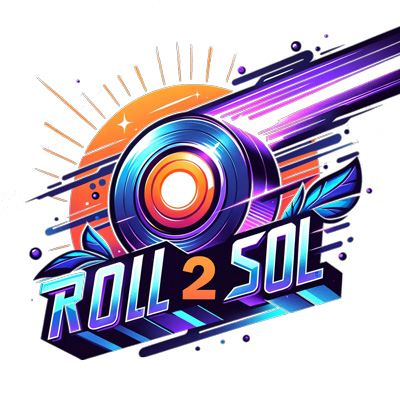

Agreementnumber Grant ID: EFRE-200800240
Maskless nanoscale plasma etching of printing rollers for roll-to-roll production of functional films using UV nanoimprint lithography
The Roll2Sol project is developing an innovative process chain for the production of printing rollers with sub-µm surface structuring. These are to be used in the production of functional films in a roll-to-roll process. One application is photocatalytic structures that can be used in green H₂ production. Anti-soiling structures can also be produced to reduce the adhesion of water and dirt to the surface of solar cells. Overall, the generation of solar energy can thus be optimized. Both applications promote renewable energies and are in line with NRW and EU
Project partners: Schepers GmbH & Co KG, Fraunhofer-Institut für Lasertechnik ILT, DLR e.V., EdgeWave GmbH, polyscale GmbH & Co. KG, AMO GmbH
09/2022 – 08/2026 – SOLID – Sustainable manufacturing and optimized materials and interfaces for lithium metal batteries with digital quality control
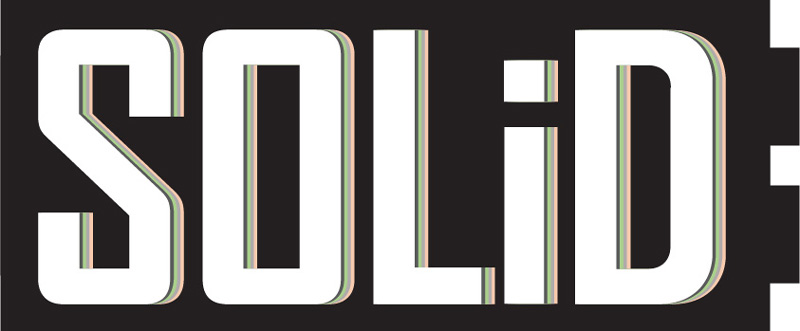

The SOLiD project will use roll-to-roll (R2R) dry extrusion coating for the blend of cathode active material, solid polymer electrolyte, and conducting additives.
R2R slot die-coated primers on the cathode current collector will enhance adhesion, performance and corrosion resistance of the cell. The polymer electrolyte layer will be R2R coated, using an optimal design for the slot die head. For the Li metal anode, cost-efficient R2R pulsed laser deposition will be utilized, minimizing the Li thickness down to 5 µm. The Li metal production will be combined with an inline process for interfacial engineering to ensure compatibility with the other layers and stability. The process development will be supported by digitalization methods to go towards zero-defect and cost-efficient manufacturing.
Coatema’s tasks in the project are the design of slot dies for the coating of Solid State Polymer Electrolyte SSPE and the development of automatic gap adjustment for slot die. The latter will also be used in the feedback control for automated coating development.
01/2023 – 12/2026 – Flex2Energy – Automated Manufacturing Production Line for Integrated Printed Organic Photovoltaics


https://cordis.europa.eu/project/id/101096803
Flex2Energy is a 48-month project with an ambitious goal to manufacture reliable Integrated Photovoltaics (IPVs) by developing an automated R2R (Roll-to-Roll) Manufacturing Line for Organic PVs.
The Manufacturing Line consists of the R2R Printing & Automated Assembly Machines, with robust and adaptive in-line metrologies for quality control and Artificial Intelligence (AI) analysis implementing industry 4.0 concepts.
The IPVs will be produced in custom designs complying to the requirements of use in buildings, greenhouses for energy production & crop harvesting and automotive EV (Electric Vehicle)car roofs, to minimize landscape and to facilitate energy positive buildings. The IPV products will be installed in dedicated business cases (BIPVs, Agri-PVs, VIPVs) and will be evaluated in terms of performance, durability and social and industrial acceptance.
- Develop and upgrade manufacturing tools for design and aesthetics of OPV products, inline process quality control techniques and easily adaptable equipment design for printed PV technologies
- Integrate tools, QC, equipment to Machines to build & demonstrate automated PL manufacturing of IPVs
- High efficiency manufacturing, durable printed IPV products at a competitive cost
- Demonstrate and Validate IPVs in energy efficient buildings, automotive and agriculture industries with minimum environmental and landscape impact
- Deploy Market Strategy and Bridge the gap between PV and Building sectors
The role of Coatema is to develop the Roll-to-Roll (R2R) production line for OPV coating, integrating partner technologies such as laser scribing, inspection camera’s, coating units and exchange machine data with the data management platform.
Cooperations partner: Coatema Coating Machinery GmbH, OET – Organic Electronic Technologies, Nanotechnology Lab LTFN, Mondragon Assembly, Semilab, Workshop of Photonics, Centro Ricerche Fiat (Crf), Alumil, Hellenic Organic & Printed Electronics Association (Hope-A), Pole Fibres Energivie (Pfe), Innovation Plasturgie Composites (Ipc), In-Core Systemes (Inc), Kiriakidis Vasilios S.A., Municipality of Alba Iulia (Alba), Depia Αutomations
07/2021 – 06/2025 – Technologies for innovative switchable films as a retrofit solution for energy-saving windows and glass facades


The FLEX-G 4.0 project focuses on developing innovative switchable electrochromic (EC) films as a cost-effective retrofit solution.
These films are intended to be laminated onto existing windows, aiming to reduce the overall solar energy transmittance (g-value) of the windows, consequently decreasing the energy consumption of buildings. The project's primary objective is to research system designs and manufacturing technologies for large-scale EC films. It also investigates methods for on-site processing and application of the films onto windows and facades in existing buildings.
Additionally, the project seeks to provide solutions for off-grid energy supply, suitable switching strategies, and sensor technologies for wireless and automated control of the film's switching state. The potential energy-saving impact will be assessed in two operational buildings. Coatema's expertise in precision coating machinery plays a significant role in the development of robust, industrial-grade roll-to-roll coating and lamination processes for electrochromic films techniques within the Flex G4.0 framework.
07/2022 – 06/2024 – TiKaBe – Ink Development for Fuel Cell Catalyst Coating

TiKaBe – Ink Development for Fuel Cell Catalyst Coating
The widespread use of proton exchange membrane (PEM) fuel cell technology requires the development of innovative approaches to manufacture the membrane electrode assembly (MEA) more efficiently and rapidly. To achieve the production volumes and cost targets set by the industry, suitable high-rate coating processes must be utilized. The project "TiKaBe" (Ink Development for Fuel Cell Catalyst Coating) focuses on the development and validation of catalyst inks for large-scale coating processes. This project is part of the HyFab joint project, which aims to create a knowledge base for the automotive and supplier industries to explore fuel cell manufacturing technology.
In this context, Coatema coating machinery GmbH is actively involved in designing the industrial coating process using the digital twin concept and scaling it up to a roll-to-roll system.
Cooperation partner: Coatema, Fraunhofer ISE, IFA, assoziierte Partner: EKRA (ASYS) und Heraeus
08/2021 – 08/2024 – IDEEL


Implementation of Laser Drying Processes for Economical & Ecological Lithium Ion Battery Production – IDEEL
In recent years, lithium-ion battery technology has increasingly found its way into new markets. Due to this the manufacturing capacities of battery technologies will undergo an exponential growth. Particularly in Germany and Europe, low-emission and energy-efficient production of these batteries will play a decisive role in the context of climate change.
The production of lithium-ion batteries is a very energy-intensive process in which more than 50% of the energy costs incurred are attributable to the drying process step.
The convection dryers commonly used in the drying process only indirectly contribute the thermal energy to the material and hold considerable potential for increasing efficiency. Drying by means of diode lasers therefore represents a promising approach to a solution. In addition to increasing energy efficiency, the energy input can be controlled much faster and more flexibly. Furthermore, the integration of thermography-based inline sensor technology can improve the drying process.
The aim of the IDEEL research project is initially to realize laser-suitable electrode formulations as part of material development in order to merge the necessary processes for laser drying on a laboratory scale. Based on this work, further manufacturing processes will be developed and implemented in parallel to the scaling of the overall process, which will enable laser drying for use in industrial production environment. In addition to its consulting activities, Coatema is also assisting the project partners by developing, integrating, and realizing the demonstration of a laser drying system, in order to achieve an industrial level with web speeds of up to 30 m/min and a significant reduction in the space required as well as the energy input in the project.
09/2022 – 05/2026 – WaterProof


WaterProof: urban Waste and water Treatment Emission Reduction by utilizing CO2 for the PROduction Of Formate derived chemicals
We live in a time when the amount of CO2 in the atmosphere exceeds the records of the last 800,000 years! In order to mitigate the impact of CO2 on the environment and tackle climate change to protect future generations on earth, carbon recycling is imperative.
Among many industrial processes, the operation of wastewater treatment plants is one of the sources of greenhouse gas (GHG) emissions, especially carbon dioxide (CO2) and methane (CH4), as well as indirect emissions from energy production. The goal of the WaterProof project is to improve the carbon cycle of waste (water) by developing a novel and green biorefinery concept electrolysis process that converts CO2 emissions from urban waste treatment facilities into formic acid and eventually into consumable products such as detergents, fish leather, etc. In WaterProof, 12 European partners including Coatema Coating Machinery GmbH, Avantium Chemicals Bv, Avantium Support Bv, Fundacion Para El Desarrollo y La Innovacion Tecnologica, Fundacion Tecnalia Research & Innovation, Stichting Waternet, Ecover Co-Ordination Center, Nova-Institut für Politische und Ökologische Innovation GmbH, Nordic Fish Leather ehf, IZES gGmbH, Frames Renewable Energy Solutions B.V., NV HVC and Corporacion Centro De Ciencia y Tecnologia De Antioquia bring together their knowledge, experience and technical resources to achieve the project goals.
Coatema Coating Machinery GmbH, in close collaboration with Avantium, plays an important role in upscaling the production of gas diffusion electrodes (GDL) in WaterProof. For this purpose, Coatema will design and develop an appropriate roll-to-roll line by upgrading the Click&Coat pilot line with a high-temperature calendering module and a coating system for suspension coating.
Website: https://www.waterproof-project.eu/
09/2022 – 08/2025 – NOUVEAU
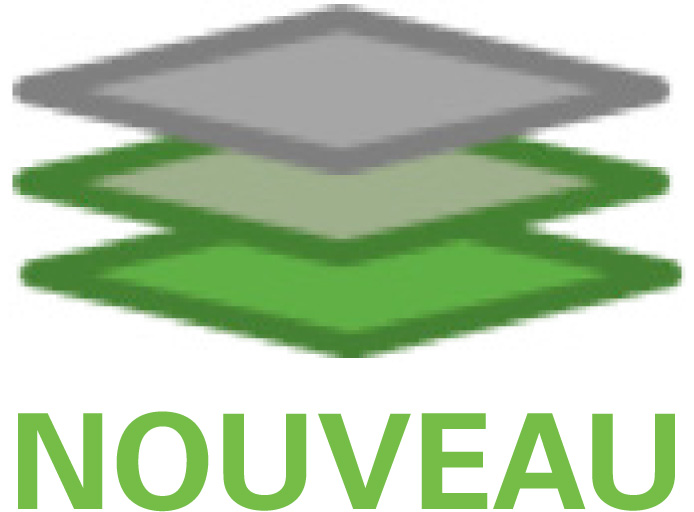

Novel Electrode coatings and Interconnect for sustainable and Reusable SOEC
The demand for green hydrogen and renewable electricity production is growing rapidly. The solid oxide electrolytic cell (SOEC) is a key technology for the production of hydrogen with high efficiency. However, a limitation in the production of SOEC is the high demand for rare earth elements (REE), which is the bottleneck of their mass production. The goal of the NOUVEAU project is to produce innovative and optimized electrode and interconnect materials with at least 30% less La, 20% less Cr content and from recycled sources. This enables SOECs to be manufactured at lower cost with improved lifetime and sustainable by design.
To achieve the goals of the NOUVEAU project, Coatema Coating Machinery GmbH is collaborating with other European partners including VITO, Forschungszentrum Jülich, Marion Technologies, Eindhoven University of Technology, QSAR Lab, IMDEA Energy, CNRS – Centre National de la Recherche Scientifique and Fiaxell SOFC Technologies.
For upscaling the electrode coating process, Coatema will develop a unique dual-slot die system to transfer gradient coating concept into the roll-to-roll process and produce electrodes with optimized microstructure. In addition, Coatema will develop an energy-efficient drying process that combines the traditional convection dryer concept with a radiation-based technology to further improve the electrode manufacturing process as part of the NOUVEAU project.
Website: https://www.nouveau-project.eu/
The R&D centre project team works with an interdisciplinary team of researchers in publicly funded projects, B2B development projects and internal Coatema research projects. The department's objective is to develop and recognise new developments in the fields of coating, printing and lamination and to drive forward the implementation of Coatema scale-up processes for new technologies and markets.
Both the scope of activities and our portfolio encompass projects in the field of organic electronics, printed electronics, thin layer solar cells, organic solar cells, perovskite solar cells, (thin layer) batteries, electrochrome components, 2D materials, inline analysis methods and much more. Since 2002, we've carried out research projects with a volume of more than 80 million euros in collaboration with more than 110 national and international partners. In the near future, one focal point of our research will be the implementation of Horizon 2020 projects and the subsequent promotion of research in EU Horizon Europe projects. In order to further strengthen the European research region, we are always interested in taking part in new projects. Please don't hesitate to contact us with your project ideas.
We work in the areas mentioned above in collaboration with many international research institutes. The presentation about our research projects provides you with an initial overview of our activities.





